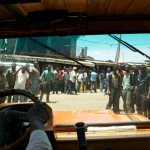The rolling friction of the tyres is the main resistance acting on a bicycle at speeds below 10 km/h (6 mph). At higher speeds, air resistance becomes far more important. It accounts for more than 80 percent of the total force acting to slow the vehicle at a speed of 35 km/h (22 mph). At this speed, it would take a power output of 345 watts just to overcome air drag when riding an upright commuting bike (on a level road in calm conditions). Riding a velomobile (a recumbent cycle with a fairing) can lower air resistance dramatically, reducing power to overcome drag to about 30 watts at a speed of 35 km/h.
 However, velomobiles are expensive. A much cheaper option is the use of a partial fairing. These wind screens, made of shatter resistant polycarbonate plastic, are mounted at the handlebars. A partial fairing is placed so that the rider is able to see over it, not through it. Apart from reducing air resistance, it is also an effective shield against bugs, rain, cold air, and road debris.
However, velomobiles are expensive. A much cheaper option is the use of a partial fairing. These wind screens, made of shatter resistant polycarbonate plastic, are mounted at the handlebars. A partial fairing is placed so that the rider is able to see over it, not through it. Apart from reducing air resistance, it is also an effective shield against bugs, rain, cold air, and road debris.
Partial fairings are available for different types of upright bicycles, and for recumbents. They weigh between 600 grams and 1.5 kg, depending on the model, including mounts. These accessoiries, which can often be seen on motorcycles, are relatively unknown to cyclists, mainly because they are outlawed in conventional bicycle racing.
When used in combination with a road bike in touring position (with the hands on the handlebar), a partial fairing brings the power required to overcome air resistance at 35 km/h down to 157 watts. This compares to 220 watts for an unfaired road bike in touring position, and to 176 watts for an unfaired road bike in (a much less comfortable) crouched position and wearing tight clothing. A partial fairing on a road bike thus offers a similar advantage to that of an unfaired recumbent (148 watts). With a headwind, the advantage of improved aerodynamics becomes even larger. One disadvantage of fairings is their sensitivity for crosswinds gusts. It takes some practice to get used to them.
The numbers above were taken from “Bicycling Science” (third edition), by David Gordon Wilson, pp 188. The result for the partial fairing concerns an older model, so it might be an underestimation. Picture: a small partial fairing by Zzipper.





